If you’re looking to upgrade your home’s climate control, I recommend checking out the top smart thermostats like ecobee’s models with sensors and air quality monitoring, Nest’s programmable Wi-Fi thermostat, and Sensi’s Wi-Fi options compatible with Alexa. These support various HVAC systems, offer energy-saving features, and integrate seamlessly with smart home platforms. Want to find the perfect fit? Keep exploring for detailed insights on each option to make an informed choice.
Key Takeaways
- Compatibility with various HVAC systems, including those without a C-wire, ensures easy installation and seamless integration.
- Compatibility with major smart home platforms like Alexa, Google Assistant, and Apple HomeKit enhances voice control and automation.
- Advanced features such as energy-saving schedules, geofencing, and adaptive learning optimize home comfort and reduce energy costs.
- User-friendly interfaces with touchscreens, intuitive apps, and sleek designs make setup and daily adjustments simple.
- Additional sensors for air quality and system monitoring improve safety, indoor air quality, and personalized climate control.
Sensi Smart Thermostat with Wi-Fi and Alexa Compatibility

If you’re looking for an easy-to-install, budget-friendly smart thermostat that doesn’t sacrifice features, the Sensi Smart Thermostat with Wi-Fi and Alexa Compatibility is an excellent choice. It supports most residential HVAC systems, often without needing a c-wire, and includes a clear 5-inch LED display. With built-in Wi-Fi, you can control it remotely via the mobile app, and it works seamlessly with Alexa, Google Assistant, and other platforms. Certified by Energy Star, it helps save around 23% on energy costs through scheduling and feedback. Its straightforward DIY installation, reliable performance, and privacy assurances make it a top contender for upgrading your home climate control.
Best For: homeowners seeking an easy-to-install, budget-friendly smart thermostat that offers reliable performance and energy savings.
Pros:
- Supports most residential HVAC systems with minimal wiring, often without a c-wire
- Easy DIY installation with built-in level tools and step-by-step app instructions
- Compatible with Alexa, Google Assistant, and other smart home platforms for voice control
Cons:
- Limited advanced programming features for complex scheduling
- May require Wi-Fi for full functionality, which could be a concern in areas with poor connectivity
- Design is basic, with a standard LED display that may not appeal to all users
ecobee Smart Thermostat Essential – Wi-Fi Thermostat Compatible with Siri, Alexa, Google

The ecobee Smart Thermostat Essential stands out as an excellent choice for homeowners seeking a versatile, easy-to-install Wi-Fi thermostat compatible with major voice assistants like Siri, Alexa, and Google. It offers significant energy savings—up to 23% annually—by customizing schedules, reducing energy when away, and optimizing comfort at home. Installation is straightforward, even without a C-wire, thanks to the optional Power Extender Kit. Its intuitive color touchscreen and app control make adjustments simple. Plus, it integrates seamlessly with smart home systems, and optional sensors enhance comfort and efficiency. Regular software updates guarantee the thermostat stays current with new features and improvements.
Best For: homeowners seeking an easy-to-install, energy-efficient smart thermostat compatible with multiple voice assistants and smart home ecosystems.
Pros:
- Easy DIY installation, even without a C-wire, with optional Power Extender Kit
- Compatible with 85% of HVAC systems, including various fuel types and heating methods
- Integrates seamlessly with Apple HomeKit, Google Assistant, and Alexa for voice control and automation
Cons:
- Optional sensors sold separately, which can add to the overall cost
- Some users may find the color touchscreen less customizable compared to other models
- Limited advanced features without additional sensors or upgrades
ecobee Smart Thermostat Premium with Sensor and Air Quality Monitor

Looking for a smart thermostat that combines energy efficiency with advanced air quality monitoring? The ecobee Smart Thermostat Premium does just that, saving up to 26% on energy costs annually. It includes a SmartSensor for targeted room comfort and a built-in air quality monitor that alerts you to poor conditions and offers tips. Its vibrant display, occupancy sensing, and sleek design make it both functional and stylish. Supporting geofencing, it automatically adjusts when windows or doors stay open, saving energy. Compatible with most HVAC systems, it’s easy to install with a Power Extender Kit and integrates seamlessly with Alexa, Google, Apple, and more.
Best For: homeowners seeking an energy-efficient, smart thermostat with advanced air quality monitoring and seamless smart home integration.
Pros:
- Saves up to 26% annually on heating and cooling costs, reducing energy bills.
- Includes SmartSensor and air quality monitor for targeted comfort and safety alerts.
- Supports voice control and automation through Alexa, Google, Apple, and more, plus built-in smart speaker capabilities.
Cons:
- Requires subscription for some advanced security and sensor features.
- Installation may be complex for non-technical users, despite included accessories.
- Compatibility with certain HVAC systems or smart home setups may vary, necessitating verification.
ecobee Smart Thermostat Enhanced with Wi-Fi and Voice Compatibility

For homeowners seeking a smart thermostat that combines energy savings with seamless voice control, the ecobee Smart Thermostat Enhanced with Wi-Fi and Voice Compatibility stands out. It can save up to 26% annually on heating and cooling costs by automatically adjusting temperatures when you’re away and preheating or precooling your home before you arrive. It works with Siri, Alexa, Google Assistant, and other platforms, plus features a SmartSensor for room-specific comfort. Easy to install, it supports most HVAC systems and connects via the Ecobee app for remote control. Its design is Energy Star certified, ensuring efficiency, while its user-friendly interface makes daily management simple.
Best For: homeowners seeking an energy-efficient, voice-compatible smart thermostat with easy installation and remote control capabilities.
Pros:
- Saves up to 26% annually on heating and cooling costs through automatic adjustments and preconditioning.
- Compatible with major voice platforms like Siri, Alexa, and Google Assistant for seamless voice control.
- Supports most 24 VAC HVAC systems with a straightforward installation process, including Power Extender Kit options.
Cons:
- May require technical knowledge for installation, especially if a C-wire is needed.
- The initial setup and configuration could be complex for some users unfamiliar with smart thermostats.
- Limited to homes with compatible HVAC systems, which may exclude certain older or specialized systems.
Sensi Lite Smart Thermostat
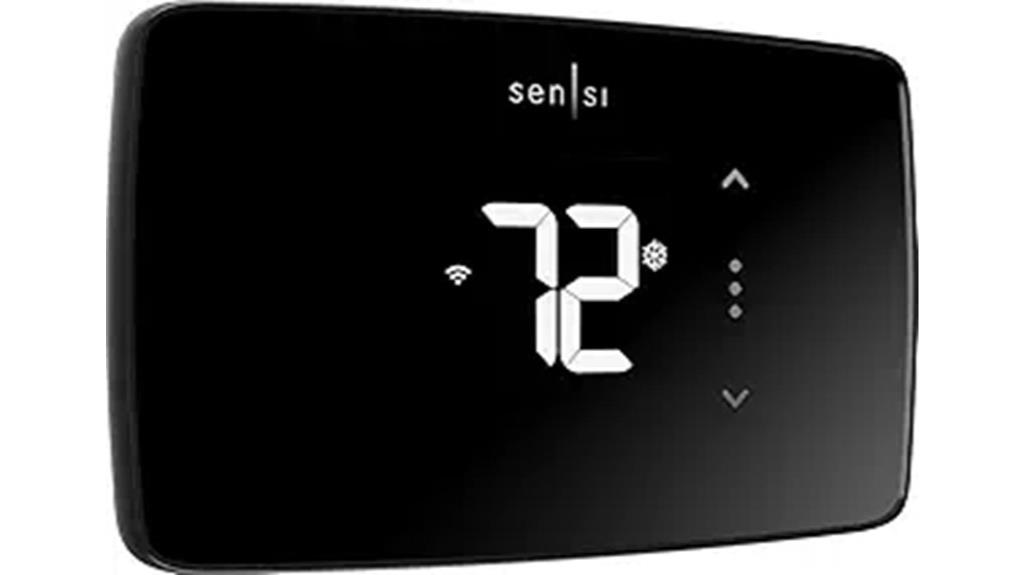
If you’re seeking an affordable, easy-to-install smart thermostat that offers reliable Wi-Fi control, the Sensi Lite Smart Thermostat stands out as an excellent choice. Its user-friendly design includes a built-in level and step-by-step instructions, making DIY installation straightforward. Compatible with most HVAC systems, it requires a C-wire only for heat pump and heat/cool setups. The thermostat features Wi-Fi connectivity, works with Alexa for voice commands, and lets you control your climate remotely via Android or iOS apps. Certified by ENERGY STAR, it helps reduce energy costs by about 23%, with scheduling, geofencing, and usage reports to optimize efficiency.
Best For: homeowners seeking an affordable, easy-to-install smart thermostat with reliable Wi-Fi control and energy-saving features.
Pros:
- Easy DIY installation with built-in level and step-by-step instructions
- Compatible with most HVAC systems and works with Alexa for voice control
- ENERGY STAR certified, helping to reduce HVAC energy costs by approximately 23%
Cons:
- C-wire required for heat pump and heat/cool systems, not needed for most others
- Limited advanced features compared to higher-end smart thermostats
- Does not sell personal information or use activity data for advertising, which may limit targeted features
Sensi Touch 2 Smart Thermostat with Touchscreen
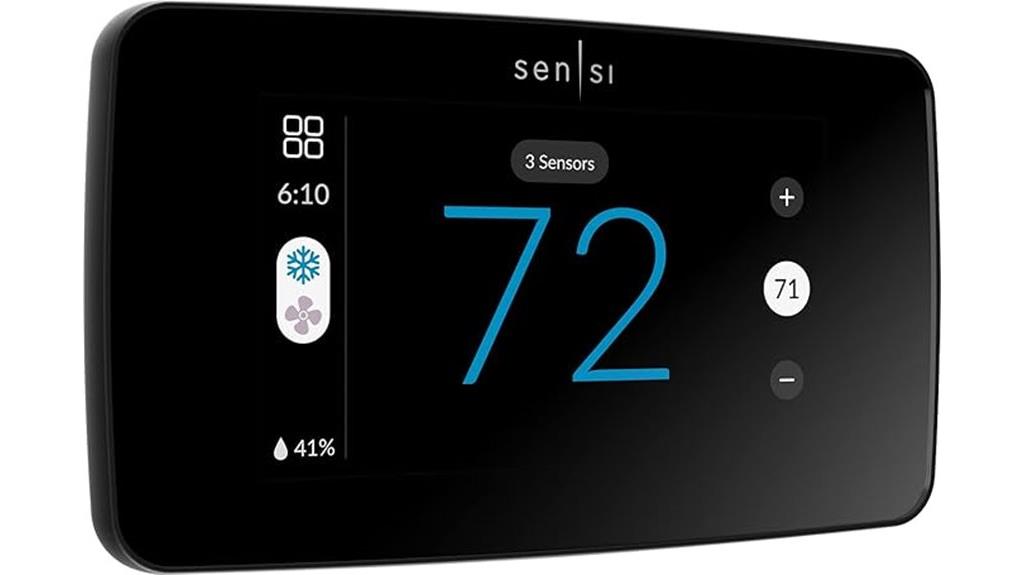
The Sensi Touch 2 Smart Thermostat with Touchscreen stands out as a top choice for homeowners seeking an intuitive, energy-efficient control system. Its color touchscreen provides easy, visual programming, while compatibility with Alexa allows voice commands. It works seamlessly with Sensi Room Sensors to balance temperatures across rooms and uses Bluetooth for straightforward DIY installation. ENERGY STAR certification means it can cut HVAC energy use by around 23%. Plus, it offers flexible scheduling, remote access, and detailed reports. Designed for long-term reliability, it’s backed by a century of expertise and prioritizes user privacy. It’s a smart, user-friendly upgrade for modern home climate control.
Best For: homeowners seeking an easy-to-use, energy-efficient smart thermostat with customizable controls and reliable performance.
Pros:
- Intuitive color touchscreen display for simple programming and control
- Compatible with Alexa for hands-free voice commands and smart home integration
- ENERGY STAR-certified, reducing HVAC energy consumption by approximately 23%
Cons:
- Requires a C-wire (common wire) for proper operation, which may not be present in all homes
- Uses Bluetooth technology, which may have limited range compared to Wi-Fi-enabled devices
- Sensi Room Sensors are sold separately, adding to overall cost for room-specific temperature balancing
Google Nest Thermostat, Smart Wi-Fi Thermostat for Home

With its ENERGY STAR certification and smart scheduling features, the Google Nest Thermostat is an excellent choice for homeowners seeking to reduce energy bills while maintaining comfort. It connects via Wi-Fi and supports most heating, cooling, and zone systems, with easy installation typically completed in 30 minutes. The device allows remote control through the Google Home app and voice commands with Google Assistant or Alexa. It automatically turns down when no one is home, saving energy, and offers alerts for system issues. Integration with Nest Renew promotes clean energy use, helping you lower utility costs and environmental impact effortlessly.
Best For: homeowners seeking an energy-efficient, easy-to-install smart thermostat that offers remote control and voice command capabilities.
Pros:
- ENERGY STAR certified for energy savings and environmental benefits
- Supports Wi-Fi connectivity and voice control via Google Assistant and Alexa
- Easy self-installation typically completed within 30 minutes
Cons:
- Compatibility checks are recommended, which may be complex for some HVAC systems
- Requires batteries for power, which may need replacement over time
- Limited display size may affect visibility in certain lighting conditions
EMERSON Sensi Touch Wi-Fi Smart Thermostat

The Emerson Sensi Touch Wi-Fi Smart Thermostat stands out for its sleek touchscreen color display and easy installation, making it ideal for homeowners seeking a user-friendly and stylish upgrade to their HVAC control. It’s compatible with Alexa, Apple HomeKit, Google Assistant, and Samsung SmartThings, offering seamless smart home integration. Most installations take less than 30 minutes using step-by-step app instructions, and no painting or patching is needed thanks to its standard size. With remote control via the Sensi app, flexible scheduling, and geofencing, you can easily personalize comfort and save energy—roughly 23% on HVAC costs—while monitoring system health and indoor air quality.
Best For: homeowners seeking a stylish, easy-to-install smart thermostat with seamless smart home integration and energy-saving features.
Pros:
- Sleek touchscreen color display with intuitive interface
- Compatible with Alexa, Apple HomeKit, Google Assistant, and Samsung SmartThings for versatile smart home control
- Easy installation completed in less than 30 minutes with step-by-step app guidance
Cons:
- Requires a C-wire for installation, which may not be present in all systems
- Energy Star certification suggests energy savings but actual results may vary based on usage
- Max humidity tolerance is 90% non-condensing, which may be limiting in very humid environments
Google Nest Thermostat and Sensor (4th & 2nd Gen)

If you’re looking for a smart thermostat that combines advanced compatibility with seamless smart home integration, the Google Nest Thermostat (4th gen) and its accompanying Sensor (2nd gen) are excellent choices. The 4th-gen thermostat works with most 24V systems—gas, electric, oil, heat pump, and more—without needing a C wire in most homes. It features a larger display, Dynamic Farsight, and customizable options like clock or weather. The included Nest Sensor helps maintain consistent comfort across different rooms by regulating temperature precisely. Plus, it learns your habits and adjusts automatically, helping you save energy while providing easy control through the Google Home app and voice commands.
Best For: homeowners seeking an energy-efficient, easy-to-install smart thermostat compatible with a wide range of HVAC systems and integrated with smart home devices.
Pros:
- Compatible with most 24V heating and cooling systems, often without needing a C wire
- Larger display with Dynamic Farsight for easy viewing from across the room
- Learns household patterns to optimize comfort and reduce energy costs
Cons:
- May require additional sensors for optimal performance in larger or multi-room homes
- Some users might find the setup process complex depending on existing wiring
- Limited customization options for display personalization compared to some competitors
meross Smart Thermostat for Home with WiFi, Alexa, Apple Home, Google Assistant, and App Control

For homeowners seeking seamless control over their heating and cooling systems, the meross Smart Thermostat stands out as an excellent choice. It’s compatible with 95% of HVAC systems, including conventional, heat pump, and cooling-only setups, though it needs a C-wire (or a meross adapter if you don’t have one). With Wi-Fi, it supports Apple Home, Alexa, Google Assistant, and Samsung SmartThings, allowing voice and app control from anywhere. Its scheduling features and smart alerts help optimize energy use, saving money. Designed for DIY installation in under 30 minutes, it offers real-time monitoring and personalized comfort, making it a versatile upgrade for any smart home.
Best For: homeowners looking for an easy-to-install, versatile smart thermostat that seamlessly integrates with popular voice assistants and supports energy-efficient scheduling.
Pros:
- Compatible with 95% of HVAC systems, including heat pumps and conventional setups.
- Supports multiple smart home platforms like Apple Home, Alexa, Google, and SmartThings.
- DIY installation process takes under 30 minutes with app-guided setup.
Cons:
- Requires a C-wire for proper operation; a compatible adapter must be purchased if absent.
- Only supports 2.4GHz Wi-Fi networks, limiting connectivity options in some environments.
- Not compatible with electric baseboard heaters.
Emerson Sensi Touch Wi-Fi Smart Thermostat
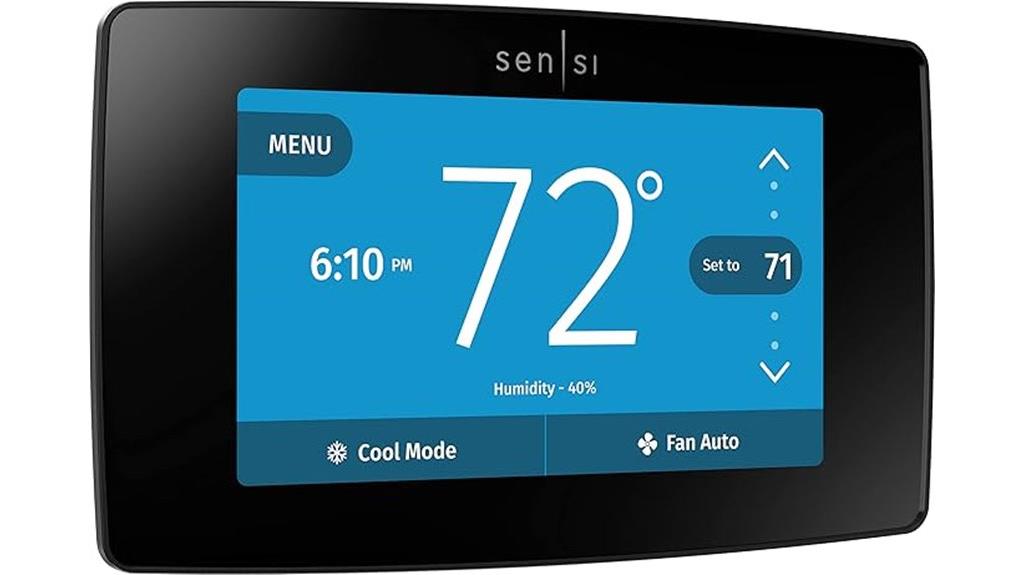
With its large, sleek touchscreen display and modern design, the Emerson Sensi Touch Wi-Fi Smart Thermostat stands out as an excellent choice for homeowners seeking an intuitive and stylish way to control their home climate. Its 5.625″ x 3.4″ x 1.17″ color screen is easy to read and fits seamlessly into any decor, available in black, white, or silver. Installation is straightforward with built-in level and step-by-step app instructions, making it DIY-friendly. It’s compatible with most HVAC systems, requires a c-wire, and helps reduce energy use by about 23%. Plus, remote control via the Sensi app adds convenience and peace of mind.
Best For: homeowners seeking an easy-to-install, stylish, and energy-efficient smart thermostat with remote control capabilities.
Pros:
- Sleek, modern touchscreen display available in multiple colors for stylish integration
- Easy DIY installation with built-in level and step-by-step app guidance
- Helps reduce energy costs by approximately 23% through flexible scheduling and remote access
Cons:
- Requires a common wire (c-wire) for operation, which may not be available in all systems
- Compatibility limited to most HVAC systems but may not support some specialized setups
- Does not sell personal data, which could limit certain data-sharing features or integrations
Honeywell Smart Wi-Fi Color Thermostat (RTH9600WF)
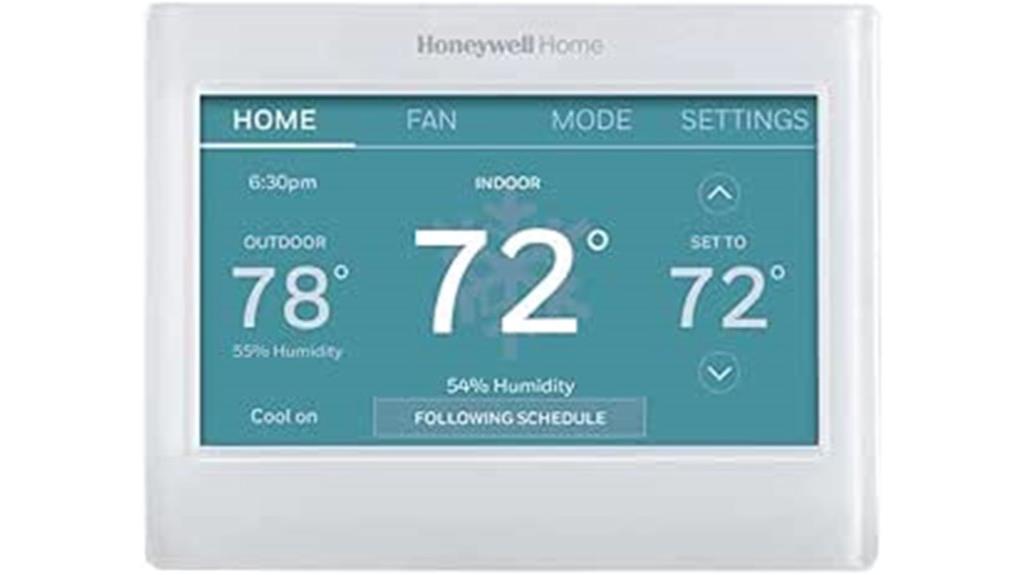
The Honeywell Smart Wi-Fi Color Thermostat (RTH9600WF) stands out as a top choice for homeowners seeking a customizable, energy-efficient thermostat that integrates seamlessly with smart home systems. It features an HD, color touchscreen display showing indoor and outdoor temperatures, humidity, and weather forecasts. Supporting flexible scheduling, smart alerts, and adaptive learning, it helps optimize comfort and energy savings. Compatible with Alexa, Google Assistant, and other platforms, it offers remote control via app. While it requires a C-wire and isn’t suited for electric baseboard heat, its intuitive interface and robust features make it a reliable upgrade for many heating and cooling setups.
Best For: homeowners seeking a customizable, energy-efficient smart thermostat that integrates easily with voice assistants and smart home platforms.
Pros:
- High-definition, customizable color touchscreen display for easy control and information at a glance
- Supports flexible scheduling, smart alerts, and adaptive learning for optimal comfort and energy savings
- Compatible with popular smart home assistants like Alexa, Google Assistant, and SmartThings for seamless voice control
Cons:
- Requires a C-wire for installation, which may not be available in all homes
- Small size may leave visible mounting holes from previous devices, and no cover plate is included
- Limited fan modes (ON, AUTO, CIRCULATING) and humidity readings may vary from external sensors
Honeywell Wi-Fi Smart Color Thermostat
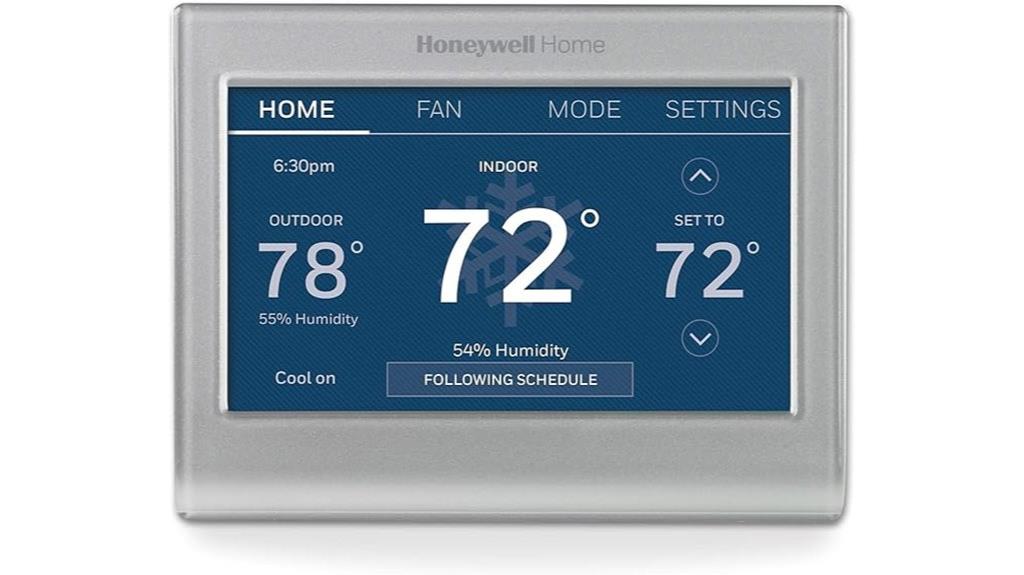
If you’re looking to customize your home’s aesthetics while enjoying smart control, the Honeywell Wi-Fi Smart Color Thermostat stands out thanks to its customizable color options. Its bright, easy-to-read touchscreen makes programming simple and intuitive. The 7-day schedule offers flexibility to match your routines and utility rates. It works with various systems like gas, oil, electric, hot water, steam, and heat pumps, but not electric baseboard heat. A C-wire is needed for power. Plus, it integrates smoothly with Alexa and Google Home, and the mobile app allows remote control, enhancing convenience and energy efficiency.
Best For: homeowners seeking customizable, energy-efficient smart temperature control compatible with multiple heating and cooling systems.
Pros:
- Customizable color options to match home décor
- Easy-to-read touchscreen with intuitive programming
- Seamless integration with voice assistants and mobile app for remote control
Cons:
- Requires a C-wire for power, which may not be available in all homes
- Not compatible with electric baseboard heating systems
- Compatibility depends on existing home wiring; verification needed before purchase
Google Nest Thermostat, Programmable WiFi Thermostat

Anyone looking to optimize home energy use and enjoy remote control will appreciate the Google Nest Thermostat. It’s a sleek, ENERGY STAR certified device that helps save energy by adjusting settings when your home is unoccupied. With the Google Home app, I can easily control it from anywhere on my Android or iPhone. The LCD display is clear, and installation takes about 30 minutes. It works without a C wire in most homes and monitors HVAC health, sending alerts for potential issues. Compatible with Google Assistant and other voice platforms, it offers convenient scheduling and remote management, making home climate control smarter and more efficient.
Best For: homeowners seeking an easy-to-install, energy-efficient smart thermostat with remote control capabilities.
Pros:
- Easy installation within approximately 30 minutes without the need for a C wire in most homes
- Supports remote control and scheduling via the Google Home app on Android and iPhone
- ENERGY STAR certified, helping to reduce energy consumption and costs
Cons:
- Lacks a lock feature, which may allow family members to change settings remotely without restrictions
- May require a compatible power accessory for certain HVAC systems, such as heating-only or zone-controlled systems
- Limited to Wi-Fi networks supporting 2.4 GHz and 5 GHz protocols; may experience connectivity issues in complex network setups
Factors to Consider When Choosing Smart Thermostats

When choosing a smart thermostat, I focus on compatibility with my HVAC system to guarantee it works seamlessly. I also consider how easy it is to install and whether it integrates well with my existing smart home devices. Finally, I look for features that save energy and a user interface that’s simple and intuitive to use.
Compatibility With HVAC Systems
Ensuring your smart thermostat is compatible with your HVAC system is essential for seamless operation and maximizing its features. First, verify whether your system is a forced air, heat pump, boiler, or electric baseboard, as each requires different compatibility considerations. Check if a C-wire is needed; some systems rely on it for power, while others can run without. Make sure the thermostat supports your specific components, like multi-stage heating or cooling, to open full functionality. Use manufacturer tools or online resources to confirm compatibility before buying. Be aware that certain systems, such as electric baseboard heaters, may not work with standard smart thermostats and might need specialized models. Confirming compatibility upfront saves you time and hassle later.
Ease of Installation
Choosing a smart thermostat that’s easy to install can save you time and frustration. Look for models with built-in level tools and clear step-by-step app instructions, making setup straightforward. Compatibility is key, so pick a thermostat that works with most HVAC systems and check if a C-wire is needed. Universal mounting plates and simple wiring diagrams also help reduce setup time. For DIY enthusiasts, thermostats with illuminated terminals and quick-start guides make installation easier. Additionally, devices supporting wireless setup options like Bluetooth or Wi-Fi allow you to configure your thermostat via smartphone or tablet without hassle. Prioritizing these features ensures a smooth installation process, so you can enjoy your smart thermostat’s benefits sooner and with less stress.
Smart Home Integration
Integrating a smart thermostat into your existing smart home setup requires careful attention to compatibility and connectivity options. First, confirm the thermostat works seamlessly with your ecosystem, whether that’s Alexa, Google Assistant, Apple HomeKit, or SmartThings. Support for voice control and automation features makes it easier to integrate into daily routines. Check if the thermostat can connect with other smart devices like sensors, security systems, or voice assistants for a unified experience. Remote access via a dedicated app is essential, so you can control your climate from anywhere. Finally, verify that the device supports standard protocols like Wi-Fi, Bluetooth, or Matter, ensuring reliable and versatile connectivity within your smart home network. This compatibility guarantees smooth operation and effortless control.
Energy Saving Features
Energy-saving features are a key factor when selecting a smart thermostat, as they can substantially reduce your utility bills and environmental impact. Many models include scheduling and geofencing that optimize heating and cooling based on when you’re home or away, cutting energy use by up to 26%. Real-time energy reports and tips help identify inefficiencies, making it easier to lower costs. Auto-away modes and adaptive learning automatically adjust settings when the house is unoccupied or during different times of day, conserving energy without sacrificing comfort. Compatibility with energy grid programs allows participation in demand response initiatives, earning incentives and reducing waste further. Advanced sensors, like room-specific temperature and humidity monitors, ensure precise climate control, minimizing unnecessary HVAC operation and maximizing efficiency.
User Interface Design
When selecting a smart thermostat, paying attention to its user interface design is essential for easy operation and quick adjustments. A clear, intuitive interface with a touchscreen or physical buttons makes it simple to control temperatures without frustration. High-contrast displays and backlit screens improve visibility in different lighting conditions, reducing errors. Customizable display options, like choosing between temperature, weather, or time, let you personalize your experience. A well-organized menu with straightforward icons and labels helps you find settings efficiently. Additionally, voice control compatibility and remote app access expand control beyond the device, offering convenience and flexibility. Prioritizing these features ensures that your thermostat is user-friendly and seamlessly integrates into your daily routine.
Privacy and Data Security
Choosing a smart thermostat isn’t just about features and ease of use—it’s also about how well it protects your privacy. I look for models that explicitly state they don’t sell or share my personal data with third parties. Clear privacy policies are essential, so I understand how my information is collected, stored, and used, especially regarding targeted advertising. I prefer thermostats that offer local control options, minimizing data transmission over the internet and reducing security risks. Secure data encryption, like end-to-end protocols, is a must to safeguard my information during transmission and storage. Finally, I check if the manufacturer provides regular firmware updates focused on security improvements, ensuring my device stays protected against vulnerabilities over time.
Price and Warranty
Price and warranty are key factors I consider to make certain I get the best value and peace of mind when selecting a smart thermostat. I look at the total cost, including the purchase price, installation fees, and potential energy savings over time. A longer warranty—usually between 1 to 3 years—offers better protection against defects and malfunctions. It’s important to review what the warranty covers, such as parts, labor, or replacements, so I know I’m fully protected. I also compare warranty terms and read customer reviews to gauge the manufacturer’s confidence in their product’s durability. Generally, higher-priced thermostats tend to have more extensive warranties, giving me added confidence in my investment and long-term support.
Frequently Asked Questions
How Secure Is My Data With These Smart Thermostats?
I feel confident that my data is secure with smart thermostats because reputable brands use strong encryption and regular security updates. They prioritize protecting user information and often have multiple layers of security. Of course, I make certain to use strong, unique passwords and enable two-factor authentication when possible. Staying cautious and keeping software up-to-date helps me guarantee my data stays private and safe from potential threats.
Can I Install These Thermostats Myself or Need Professional Help?
You can often install smart thermostats yourself if you’re comfortable with basic DIY projects. Most models come with clear instructions and straightforward wiring diagrams. However, if you’re unsure about handling electrical connections or your system is complex, I recommend hiring a professional. This guarantees proper installation, avoids potential damage, and ensures your thermostat functions correctly. When in doubt, professional help is a smart choice for peace of mind.
Do All Models Support Multi-Zone or Multi-Room Control?
Not all models support multi-zone or multi-room control, so it’s like comparing apples to oranges. Some smart thermostats are designed to manage multiple areas, giving you a centralized command over your home’s climate, while others focus on a single zone. If multi-room control is a must, look for models explicitly stating this feature. Always double-check the specs to verify your chosen thermostat can handle your home’s layout seamlessly.
How Do I Troubleshoot Connectivity Issues With Wi-Fi Thermostats?
If you’re having trouble with your Wi-Fi thermostat, I recommend first checking your internet connection—make sure it’s stable and working properly. Then, restart your thermostat and router to reset the connection. Verify your thermostat’s firmware is up to date and that it’s within range of your Wi-Fi signal. If issues persist, try reconnecting it through the app or resetting it to factory settings.
Are These Thermostats Compatible With All HVAC Systems?
I’ve found that most smart thermostats are compatible with common HVAC systems, but it’s not universal. For example, I once helped a friend with an older system that wasn’t compatible without extra wiring or a relay. Before buying, I always recommend checking your thermostat’s compatibility list or consulting an HVAC professional. That way, you avoid surprises and make sure it works seamlessly with your specific system.
Conclusion
Choosing the right smart thermostat feels like finding the perfect key to open comfort and efficiency in my home. With so many options, it’s clear that the right choice depends on your needs and preferences. Remember, a smart thermostat isn’t just a device—it’s the heart of your home’s climate control. Don’t just settle—select the one that truly makes your home smarter, more comfortable, and more energy-efficient. After all, your home deserves nothing less.









